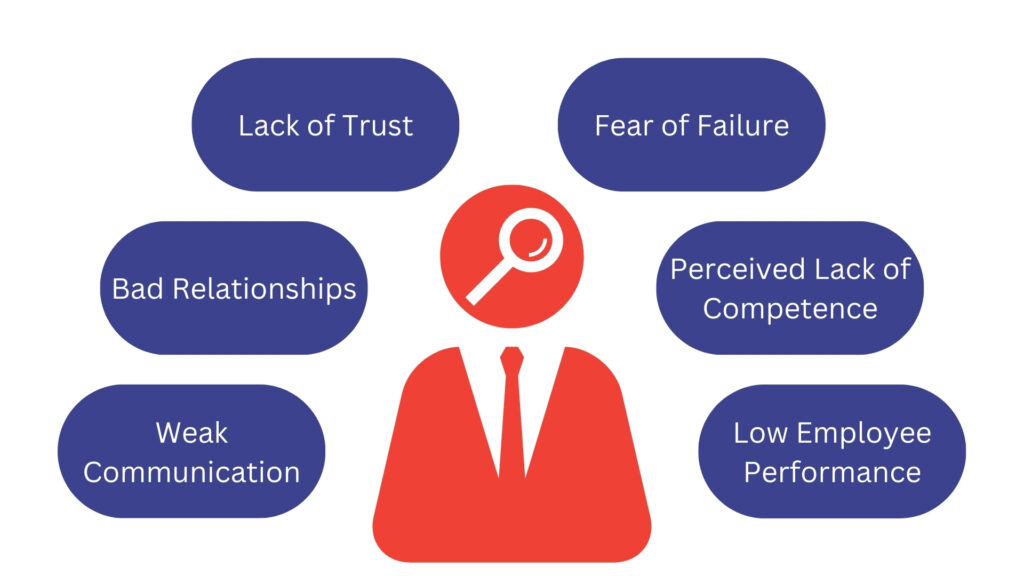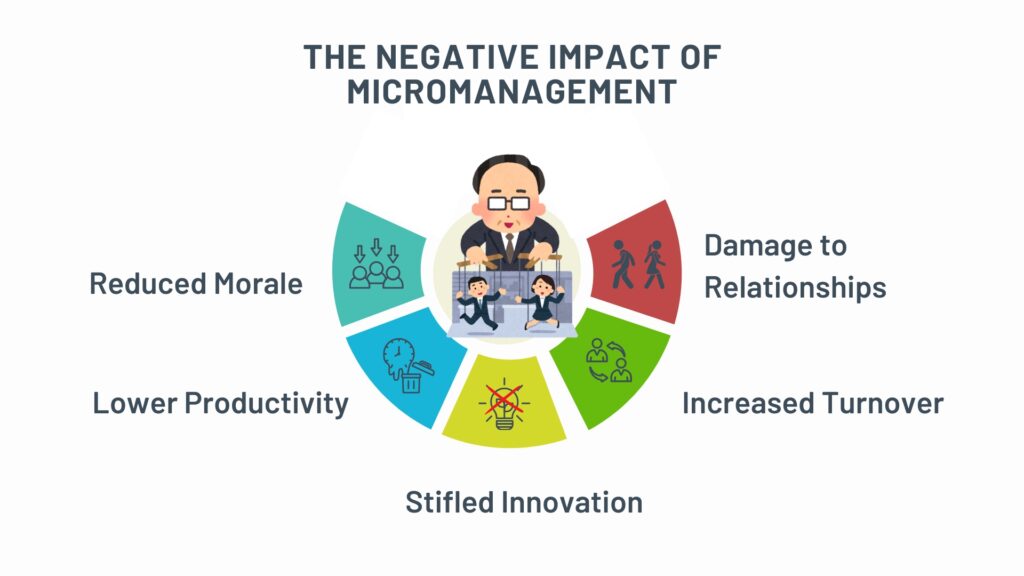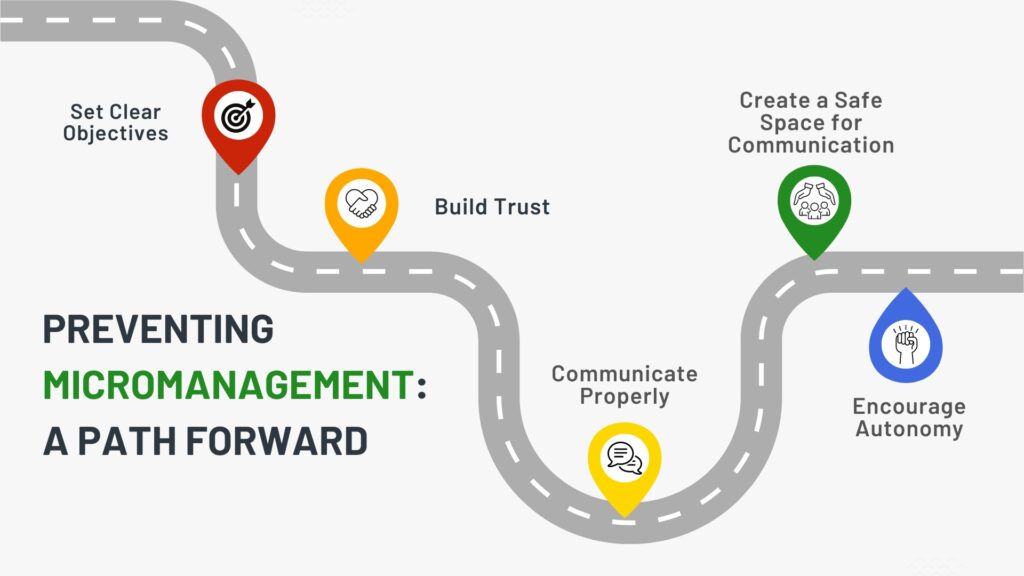Micromanagement is a common challenge in many workplaces, often leading to decreased morale, stifled innovation, and lower productivity. While managers who micromanage typically have good intentions, their approach can be more harmful than helpful. By exploring the root causes of micromanagement and strategies to overcome it, we can foster healthier, more productive work environments.
The Causes of Micromanagement
Micromanagement usually stems from a manager’s underlying fears or insecurities. These can include:
- Weak Communication: When communication between managers and employees is unclear or inconsistent, managers may feel the need to control every detail to ensure tasks are completed correctly. This can lead to micromanagement as a way to compensate for the lack of clear direction.
- Bad Relationships: Poor relationships between managers and their teams can result in a lack of understanding and trust. Without a solid relationship, managers might assume the worst about their employees’ capabilities, leading them to micromanage.
- Lack of Trust: Trust is the foundation of any successful team. When managers don’t trust their employees to perform their duties effectively, they may resort to micromanaging as a way to maintain control and ensure outcomes. The video emphasizes that trust issues often arise from past experiences where expectations weren’t met, leading managers to adopt a more hands-on approach as a precautionary measure.
- Fear of Failure: Managers may micromanage because they fear that if they don’t control every aspect of a project, it might fail. This fear often leads to excessive oversight, where managers feel that only by personally handling tasks can they ensure success.
- Perceived Lack of Competence: Sometimes, managers may doubt their team’s ability to meet high standards. This lack of confidence in employees’ abilities can lead to a micromanagement style, where the manager feels they must intervene to ensure quality.
- Low Employee Performance: If an employee’s performance is consistently below expectations, managers might feel compelled to oversee every aspect of their work. While this might seem like a solution, it can create a cycle where the employee’s performance continues to suffer due to the pressure of being micromanaged. The video discusses how this cycle can become a self-fulfilling prophecy, where micromanagement actually causes the very problems it’s intended to prevent.
The Negative Impact of Micromanagement
While micromanagement might be intended to improve outcomes, it often has the opposite effect. Here’s how it can harm a workplace:
- Reduced Morale: Employees who feel constantly monitored may become demotivated and disengaged. The lack of autonomy can lead to frustration, as they may feel that their skills and judgment are not trusted.
- Lower Productivity: Rather than boosting productivity, micromanagement can slow things down. When managers involve themselves in every detail, it can create bottlenecks, delaying decision-making and progress.
- Stifled Innovation: Creativity and innovation thrive in environments where employees feel empowered to experiment and take risks. Micromanagement, however, can stifle this by creating a culture of fear, where employees are hesitant to propose new ideas or take initiative.
- Increased Turnover: Persistent micromanagement can lead to higher turnover rates. Talented employees may leave for environments where they feel trusted and valued, leading to a loss of top talent and increased recruitment costs.
- Damage to Relationships: Healthy relationships, whether among colleagues or between management and staff, are built on trust and understanding. Improper communication and micromanagement can erode this trust, leading to a breakdown in relationships. Small issues can fester into larger conflicts, resulting in a toxic work environment.
Preventing Micromanagement: A Path Forward
To combat the negative effects of micromanagement, both managers and organizations need to take proactive steps:
- Set Clear Objectives: Employees and managers should work together to set clear, achievable objectives. When everyone is on the same page about what needs to be accomplished, there’s less need for managers to micromanage. Clear goals also give employees the autonomy to manage their tasks, which can boost confidence and performance.
- Build Trust: Trust is the foundation of any successful team. Managers should work to build trust by delegating tasks, allowing employees to take ownership of their work, and providing support rather than control. Trusting employees to do their jobs can lead to better outcomes and a more positive work environment.
- Communicate Properly: Open and consistent communication is key. Managers should articulate their expectations clearly and listen to their employees’ concerns. Regular check-ins can help ensure that everyone is aligned without the need for constant oversight. The video highlights the importance of managers asking questions and providing guidance without dictating every step, which can foster a more collaborative environment.
- Create a Safe Space for Communication: Both managers and employees should feel comfortable expressing their thoughts and concerns. Creating a safe environment where honest dialogue is encouraged can help address issues before they lead to micromanagement. When employees feel heard and supported, they’re more likely to take ownership of their work, reducing the need for micromanagement. The video suggests that this kind of environment helps to cultivate a culture of mutual respect and understanding, which can significantly reduce the tendency to micromanage.
- Encourage Autonomy: Managers should focus on empowering their employees rather than controlling them. Encouraging autonomy allows employees to develop their skills and confidence, leading to better performance and job satisfaction.

Micromanagement might seem like a way to ensure success, but it often leads to the opposite. By understanding the underlying causes and actively working to build trust, set clear expectations, and foster a collaborative environment, managers can avoid the pitfalls of micromanagement. As leadership expert John C. Maxwell once said, “A leader is one who knows the way, goes the way, and shows the way.” True leadership involves guiding and empowering others, not controlling every step. This approach not only benefits employees but also creates a more productive, innovative, and positive workplace.
Are you ready to take your leadership abilities to the next level? Discover how to inspire, motivate, and lead your team effectively with our High-Performance Leadership Training at Exeqserve. Our comprehensive training program is designed to equip you with the tools and strategies necessary to become a more impactful leader. Whether you’re looking to improve communication, foster trust, or develop your team’s potential, our expert-led sessions provide the insights and skills needed to excel in today’s dynamic workplace.
Empower yourself and your organization with leadership techniques that drive results. Learn more about the effective leadership styles that can transform your team and elevate your management approach by visiting our training services page. Let’s work together to build a stronger, more resilient leadership foundation.
About the Author
Paolo Kier Ablaza is ExeQserve’s dedicated Training Coordinator, committed to delivering high-quality and enjoyable training sessions. He supports the training facilitator, ensuring that learners acquire valuable skills in a fun and engaging environment. An aspiring trainer, Paolo’s passion and meticulous attention to detail make him an invaluable asset to the ExeQserve team.











